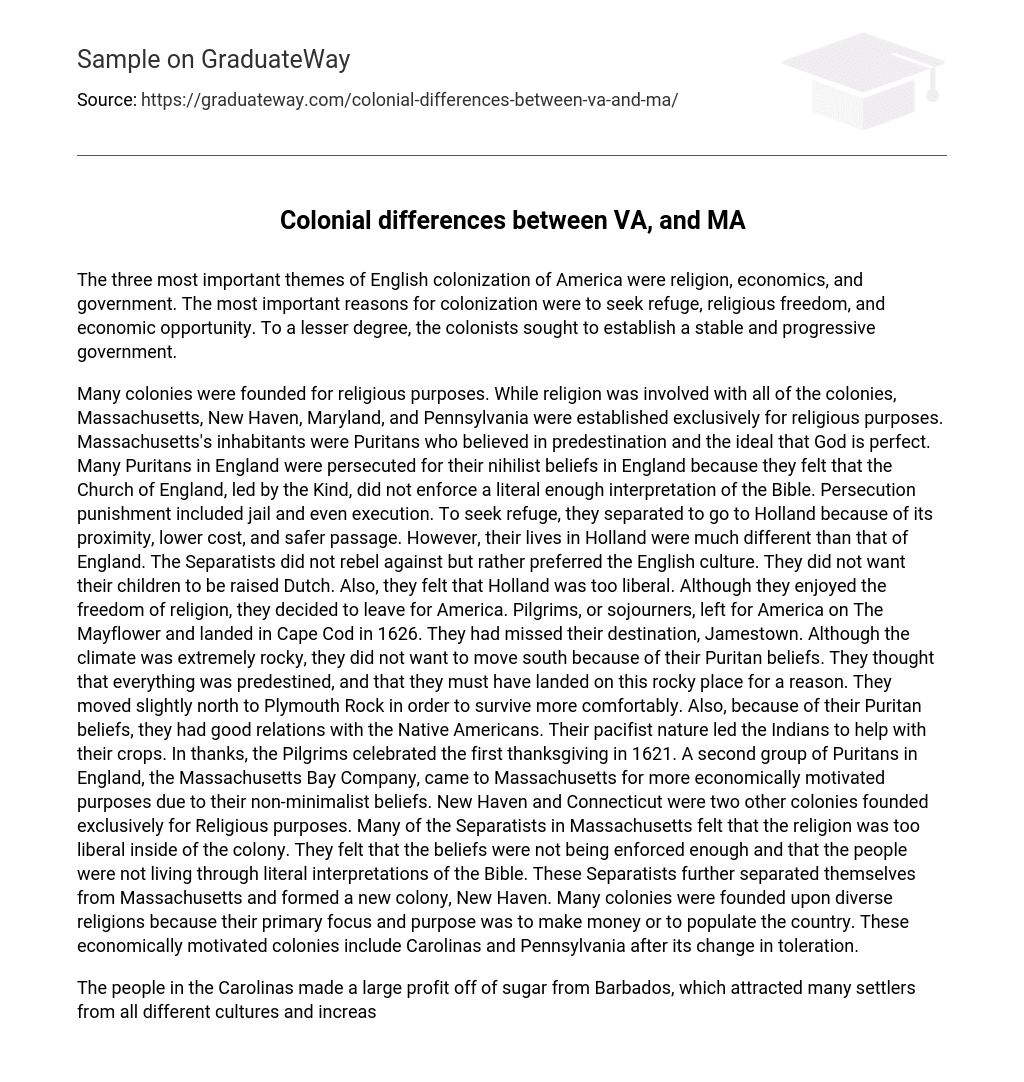The English colonization of America revolved around three significant themes: religion, economics, and government. The primary motivations behind colonization included the pursuit of refuge, religious freedom, and economic opportunities. Additionally, there was a secondary aim to establish a stable and progressive form of government.
Many colonies, including Massachusetts, New Haven, Maryland, and Pennsylvania, were established with religious intentions. The inhabitants of Massachusetts were known as Puritans who believed in predestination and the concept of a perfect God. These Puritans faced persecution in England for their belief that the Church of England did not strictly follow biblical teachings – this persecution included imprisonment and execution. As a result, they sought refuge in Holland due to its proximity, lower cost, and safer journey. However, life in Holland was different from what they were used to in England; the Separatists preferred English culture and did not want their children raised as Dutch. They felt that Holland was too liberal for their tastes. Despite enjoying religious freedom there, they ultimately decided to leave for America.
The Pilgrims embarked on The Mayflower and arrived at Cape Cod in 1626 (missing their intended destination of Jamestown). Although Cape Cod presented challenges with its climate, they chose not to move south due to their Puritan beliefs. They believed that everything was predetermined and landing in this rocky place had a purpose. Eventually settling slightly north at Plymouth Rock offered them better chances for survival.
Due to their Puritan beliefs,the Pilgrims had harmonious relations with Native Americans who helped them with their crops.In 1621,the Pilgrims marked the first Thanksgiving to express their gratitudeThe Massachusetts Bay Company and the colonies of New Haven and Connecticut had different motivations for settling in Massachusetts. The company sought economic opportunities, while the latter colonies were established for religious reasons. However, some Separatists within Massachusetts believed that the colony’s religion did not adhere strictly enough to biblical interpretations. Consequently, they broke away from Massachusetts and created the New Haven colony. Various colonies were founded with varying religious goals, as their primary objectives were either economic gain or population growth. The Carolinas and Pennsylvania serve as illustrations of economically driven colonies that emerged following changes in toleration policies.
The Carolinas experienced a significant economic gain from the sugar trade with Barbados. This attracted settlers from diverse backgrounds and resulted in a population increase. As a result of the prosperous sugar industry, migration and immigration between the Carolinas and other colonies became frequent. Puritans from Massachusetts and Catholics from Maryland arrived in the Carolinas to benefit from its wealth. Notably, unlike any other colony at the time, the Carolinas welcomed individuals of all religious beliefs, going beyond accepting only Christian faiths.
Pennsylvania initially served as a religious refuge and later embraced all faiths for economic survival. Quakers from various regions migrated there, creating a diverse culture. The establishment of English colonies in the New World led to the development of government and democratic ideals. Virginia’s weak government gradually became more democratic, though still not like today’s pure democracy. Massachusetts began with the Mayflower Compact, establishing a theocracy under clergy while pledging loyalty to England. The Massachusetts Bay Company later established a general court for economic and religious purposes, but faced challenges due to misrepresentation by the elected freemen who prioritized their own interests over the colony’s welfare.In addition, the limited opportunity for making crucial day-to-day decisions arose from the fact that the general court meeting only occurred four times a year.
The American colonies had various similarities and differences in their religious, economic, and governmental origins. Some colonies aimed to achieve religious diversity, while others were motivated by economic reasons. Furthermore, the colonies experienced a shift from non-representative and elitist governments to a more democratic system resembling today’s pure democracy.
The text contains a total of 855 words and spans over 24 pages.





